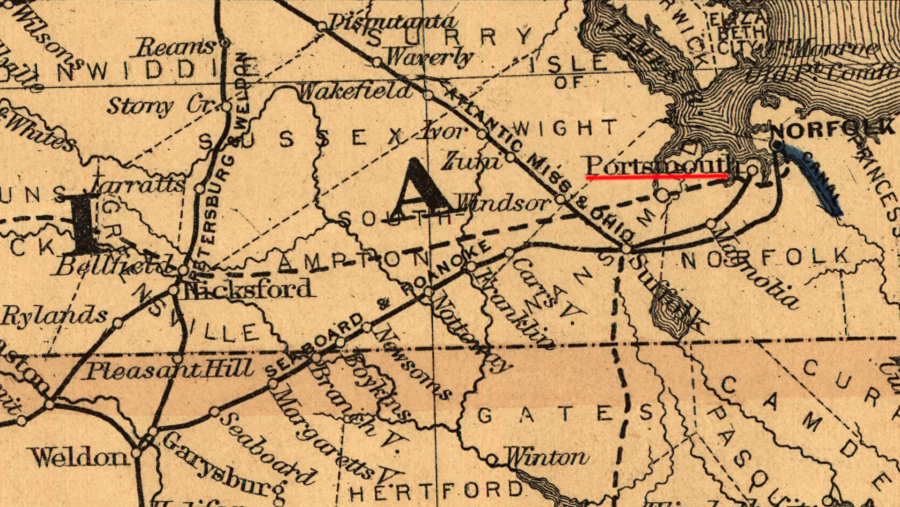
a proposal for building a new railroad west of Portsmouth (dashed line) into the Piedmont was clear by 1874
Source: Library of Congress, Map of the Seaboard & Raleigh Railroad and its connections (1874)

a proposal for building a new railroad west of Portsmouth (dashed line) into the Piedmont was clear by 1874
Source: Library of Congress, Map of the Seaboard & Raleigh Railroad and its connections (1874)
The Atlantic & Danville Railroad received its charter in 1882. At the time, the Norfolk and Western Railroad was actively expanding up the New River Valley to the coal fields near Flat Top Mountain. The General Assembly was willing to support multiple proposals to construct additional lines to Norfolk, and did not give Norfolk and Western a monopoly on railroad traffic to the port.
Though the 1882 charter authorized building to Danville, the first stage of the Atlantic & Danville Railroad was less ambitious. In 1885 it started with a three-foot narrow-gauge line. It connected Belfield and Hicksford (renamed Emporia after they merged in 1887) at the Fall Line on the Meherrin River to a new wharf at Claremont on the James River 50 miles away.
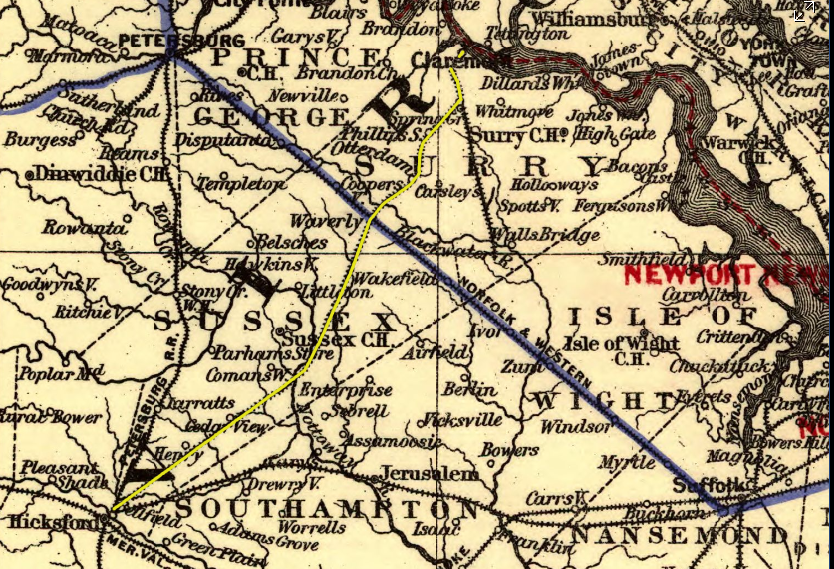
the first part of the Atlantic and Danville Railroad to be constructed was a narrow-gauge line from Emporia to Claremont (yellow line) that intersected the Norfolk and Western (blue line) at Waverly
Source: Library of Congress, Maps showing the Norfolk, Albermarle & Atlantic Railroad and its connections
The narrow-gauge track was not the first railroad to carry lumber to that part of the James River. Prior to the Civil War, Claremont Plantation built a short stretch of track to transport lumber to the James River. Like many of the initial railroad tracks in Virginia, the plantation's trains ran on a strap of iron tacked to wooden stringers.1
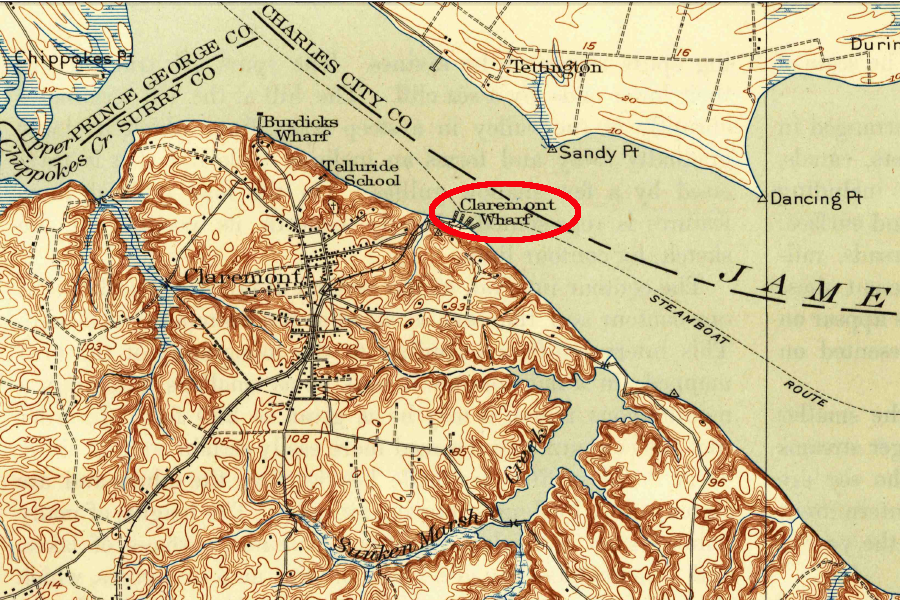
the Atlantic & Danville Railway started as a narrow-gauge line to the James River at Claremont in Surry County
Source: US Geological Survey (USGS), Surry 1:62,500 scale topographic quadrangle (1919)
The rail line to Claremont was developed under a different business model than the Petersburg Railroad or the Portsmouth & Roanoke (Seaboard and Roanoke) Railroad. Those had been justified by the opportunity to divert the traade on the Roanoke River to a port city in Virginia.
However, shipping on the Meherrin River at Belfield and Hicksford was very limited. The economic benefits of capturing the Meherrin River trade would not have justified the investment of building even a narrow-gauge railroad from the Meherrin River to the James River. The justification for the initial investment in the Atlantic & Danville Railroad was hauling wood from Southeast Virginia timberlands to a deep water port on the James River, and Claremont was chosen as that port site.
In addition to the Atlantic & Danville Railroad, the state legislature chartered the Surry County Railroad & Lumber Co. on December 2, 1882. The two companies agreed to build one track between the lumber company's mill on the Blackwater River and Claremont, which got a town charter from the General Assembly at the start of 1886. The new port at Claremont would be 1.5 miles downstream from the lumber company's existing wharf at Sloop Point.
That arrangement lasted until 1886, when the Surry County Railroad & Lumber Co. reorganized after bankruptcy. The successor railroad, the Surry, Sussex and Southampton Railway, stopped bringing timber products to Claremont. It built a separate narrow-gauge line to a new destination, Scotland Wharf, on the James River opposite Jamestown. The Surry, Sussex and Southampton Railway abandoned the narrow-gauge line connecting Dendron to Claremont, and only the Atlantic & Danville Railroad used the wharves at Claremont after 1886.2
The Atlantic and Danville Railroad and the Surry, Sussex and Southampton Railway followed the example of the Chesapeake and Ohio (C&O) Railroad when they sought to establish new ports on the James River in the 1880's. In 1881 the Chesapeake and Ohio (C&O) Railroad had created its port at Newport News, upstream from the existing docks at Hampton, Norfolk, and Portsmouth. Moving the C&O export docks from Richmond to Newport News was a profitable decision for that railroad.
The Chesapeake and Ohio Railroad had a steady stream of coal to haul from new mines in West Virginia to ships that docked at Newport News. The Atlantic and Danville Railroad and the Surry, Sussex and Southampton Railway exported timber products from their wharves until the supply was exhausted. However, the railroas in new ports in Surry County were unable to stimulate enough traffic in other commodities for their ports to compete with those in Hampton Roads, with deeper water and a shorter distance to the Atlantic Ocean.
Building at Claremont turned out to be a bad business decision. Without an extensuion into the cotton-growing Piedmont of the Carolinas, the Atlantic and Danville Railroad had too little product for export. Tt could attract ships interested in transporting its locally-cut lumber, but not enough other vessels would sail up the James River to Claremont for just that cargo.
The investors in the Atlantic & Danville Railroad chose to raise money to build a longer railroad, and to choose a new port site. More ships would dock at wharves on the Elizabeth River, so the railroad chose to build a new eastern terminus and a new track to Portsmouth.
In 1887 the Atlantic & Danville Railroad built new standard gauge track from Emporia to its new deepwater port at West Norfolk, on the western side of the Elizabeth River. A car ferry there enabled floating freight cars across the Elizabeth River to Norfolk. The car ferry was also used for loading/unloading the car barges of the New York, Philadelphia & Norfolk Railroad, whose track down the Eastern Shoe terminated at Cape Charles.3
"Car Transfer Bridge At West Norfolk, VA, Atlantic & Danville R. R.," Engineering News, September 19, 1895, http://www.catskillarchive.com/rrextra/rstran.Html (last checked May 17, 2020)
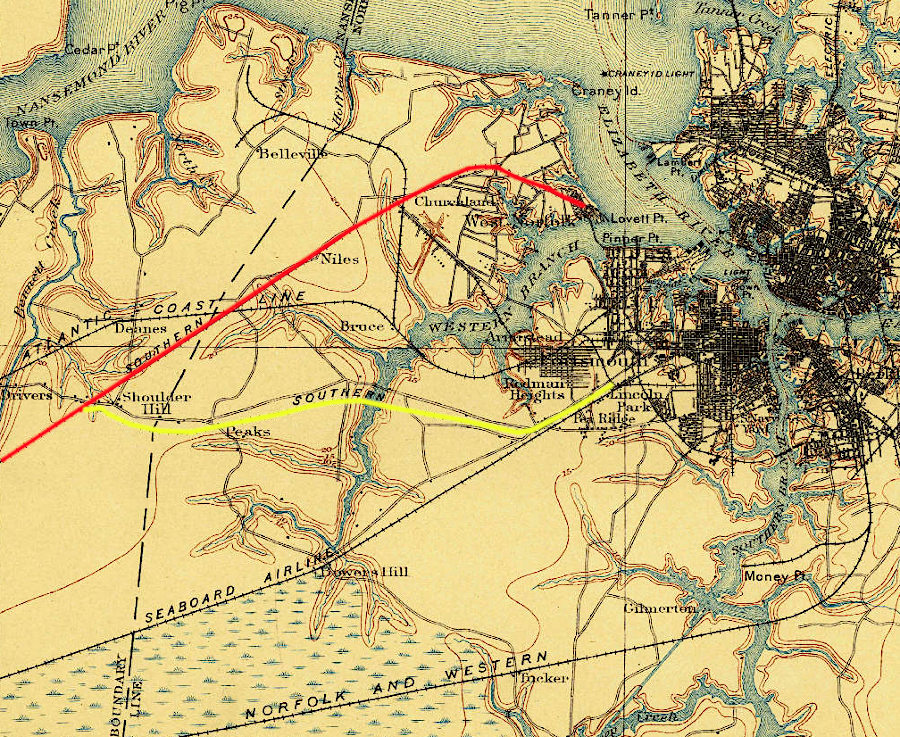
the Atlantic and Danville Railroad built track to a terminal at West Norfolk (red), then a branch to Portsmouth (yellow)
Source: US Geological Survey (USGS), Norfolk, VA 1:125,000 topgraphic quadrangle (1902)
The West Norfolk terminal was located three miles outside the boundaries of the city of Portsmouth, north of the Western Branch and across from another railroad terminal already operating at Pinners Point. The Pinners Point terminal, south of Western Branch, was used by the Norfolk and Carolina Railroad and later the Atlantic Coast Line. That terminal was built originally in 1888 by the Western Branch Railway, and survives today as the Portsmouth Marine Terminal (PMT).
The Atlantic & Danville Railroad also built a seven-mile extension from Shoulder Hill to Portsmouth. The city induced it to build that branch, buying stock in the railroad in exchange for a commitment to end passenger service to West Norfolk and direct it to Portsmouth. The railroad also committed to locate offices and a roundhouse, as well as its passenger station, within the city limits.
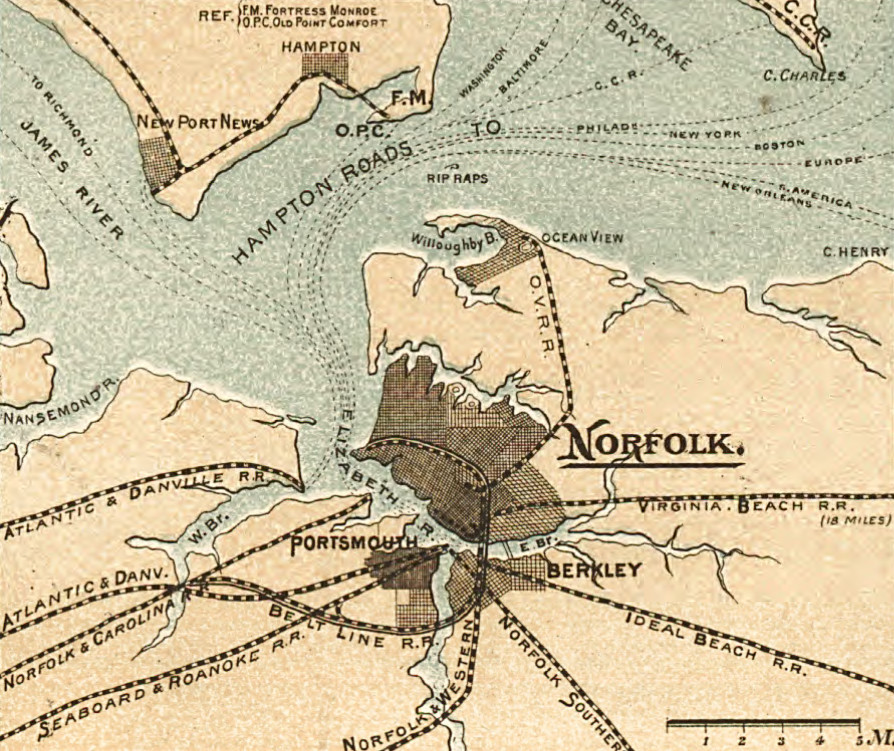
the Atlantic & Danville Railroad built two lines to separate wharves on the west side of the Elizabeth River
Source: Library of Congress, Panorama of Norfolk and surroundings 1892 (by Henry Wellge)
Then the Atlantic & Danville Railroad went through bankruptcy. It was renamed in 1894 the Atlantic & Danville Railway.3
"Atlantic & Danville Railway Company," Annual Report, Virginia, Railroad Commissioner, 1898, p.500, https://books.google.com/books?id=mCUaAQAAIAAJ (last checked June 2, 2020)
The new Atlantic & Danville Railway quickly abandoned its branch line from Shoulder Hill to the Seaboard Cotton Press in Portsmouth and removed the tracks. A subsequent court case determined that the railroad company that emerged from bankruptcy in 1894 was not obliged to honor the promise of the previous Atlantic & Danville Railroad corporation to maintain the branch line into Portsmouth. The charter from the state legislature required constructing track to the Elizabeth River, but a terminal withn Portsmouth was not required. The railroad could choose to maintain just its more-efficient West Norfolk terminal.3
"Sherwood et al. v. Atlantic and D. R. Co.," Supreme Court of Appeals of Virginia, February 11, 1897, Thomas J. Michie (editor), American and English Railroad Cases, Volume VI, 1897, pp.670-677, https://www.google.com/books/edition/_/v0UsAQAAMAAJ (last checked May 28, 2020)
SEE https://books.google.com/books?id=lxnhCn4ONJMC&pg=PA709&lpg=PA709#v=onepage&q&f=false
The 78 miles of standard gauge track were completed in 1888 between West Norfolk and Belfield, on the Meherrin River. Belfield and its neighboring community on the southern side of the river, Hicksford, were combined later into the city of Emporia.
After the Atlantic and Danville Railroad reached Jerusalem, the county seat of Southampton County, residents in that area traveled regularly to shop in Norfolk. Supposedly the merchants there commented on the "Arabs from Jerusalem," and to eliminate such derision the town changed its name to Courtland.
The name change also ended the local joke that the Atlantic & Danville Railroad was the longest in the world because it ran between Jerusalem and Scotland, the wharf on the James River.3
"You asked: Jerusalem renamed Courtland in 1888 due to railroad completion," Tidewater News, June 16, 2012, https://www.thetidewaternews.com/2012/06/16/you-asked-jerusalem-renamed-courtland-in-1888-due-to-railroad-completion/ (last checked May 18, 2020)
At Belfield and Hicksford (Emporia), the narrow gauge the Atlantic & Danville Railroad connected to the standard gauge Petersburg Railroad, providing a north-south connection between Richmond and the Roanoke River. The Petersburg Railroad combined in 1898 with he Richmond and Petersburg Railroad to initiate the Atlantic Coast Line.
Connecting just the Meherrin River to the Elizabeth River was not the intention; that link alone would not justify financing the new track. In the 1880's, there were many other railroad expansion investment opportunities. Building new track west of Emporia to Danville was part of the planned expansion beyond carrying timber products to Claremont. The railroad expected to make a profit from carrying products from the Piedmont, west of the Fall Line, to the West Norfolk terminal.3
William E. Griffin Jr., The Atlantic and Danville Railway Company, TLC Publishing, 2006, pp.2-4, pp.61-62
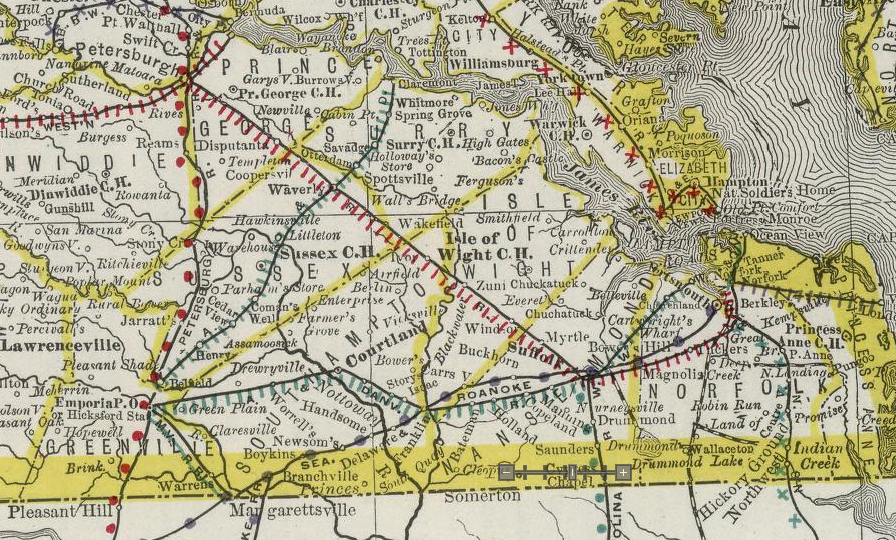
after the Atlantic and Danville Railroad started with a narrow-gauge line from Emporia to Claremont, it built a standard gauge line from Emporia to West Norfolk
Source: David Rumsey Historical Map Collection, Virginia (1889)
Between 1887-1891 the Atlantic & Danville Railroad built its standard gauge line from Emporia to Danville, going 133 miles deep into the Piedmont. It followed the route surveyed by the Norfolk and Great Western Railroad in 1872, a company that had received a charter and surveyed a path but failed to lay any track.

the Norfolk and Great Western Railroad proposed building track west from Portsmouth, past Danville and Bristol, to Cumberland Gap
Source: Library of Congress, Map of the Seaboard & Raleigh Railroad and its connections (1874)
The extension to Danville, parallel to the North Carolina-Virginia border, included 20 miles located south of that border. Crossing the state line required getting a charter from the North Carolina legislature, but following topography minimized grades requiring locomotives to climb uphill.3
"Norfolk and Great Western Railroad," Annual Reports of Internal Improvements Companies of Virginia to the Board of Public Works for the Year Ending September 30, 1872, Board of Public Works, 1872, p.112, https://books.google.com/books?id=SxhRAQAAMAAJ; "North Carolina Railroads - Atlantic & Danville Railroad," Carolana, https://www.carolana.com/NC/Transportation/railroads/nc_rrs_atlantic_danville.html (last checked May 18, 2020)
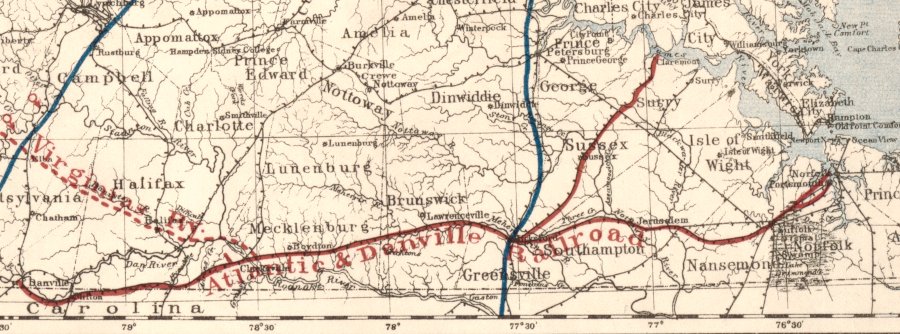
the Atlantic and Danville Railroad connected the upper Roanoke River watershed to the Chesapeake Bay
Source: Library of Congress, Map showing the location of the Virginias Railway across the grand divisions of West Virginia and Virginia from the Ohio to Hampton Roads (by Jedediah Hotchkiss, 1896)
Lawrenceville, the county seat of Brunswick, expanded to accommodate the workers at the railroad's repair shops at the midpoint of the line between Portsmouth and Danville. The Atlantic & Danville Railroad investors also created the new town of South Hill, gettig a charter with town boundaries defined in a circle which had the train depot in the center. Lots were surveyed in 1889, but South Hill was not chartered until the railroad arrived in 1901.3
"Lawrenceville Historic District," National Register of Historic Places Registration Form, Department of Historic Resources (DHR) File No. 251-5001, February 15, 2000, Section 7, p.5; Section 8, p.7, http://www.dhr.virginia.gov/registers/Counties/Brunswick/251-5001_Lawrenceville_Historic_District_2000_Final_Nomination.pdf (last checked May 17, 2020)
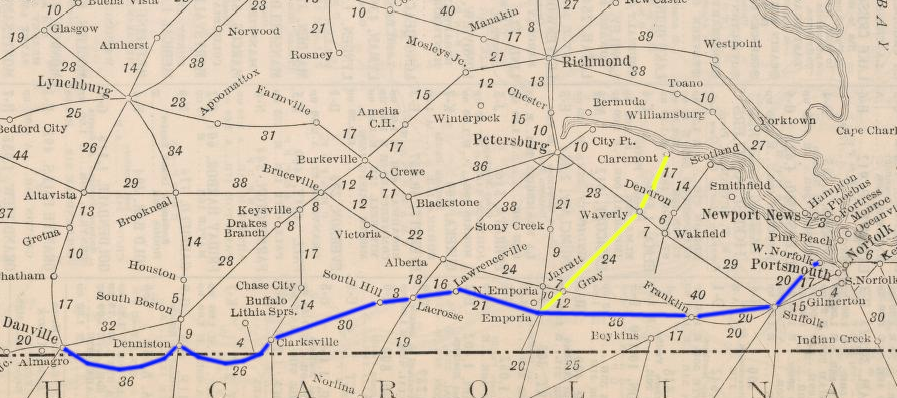
the Atlantic and Danville Railroad ended up with a narrow-gauge line from Emporia to Claremont (yellow line), plus standard gauge track from Danville to West Norfolk (blue)
Source: David Rumsey Historical Map Collection, Railway Distance Map of the State of Virginia (1934)
After construction of the standard gauge track, the 51-mile narrow gauge line to Claremont was maintained as a branch primarily to haul lumber. It was never upgraded to standard gauge, because it never generated enough business to justify the cost of conversion.
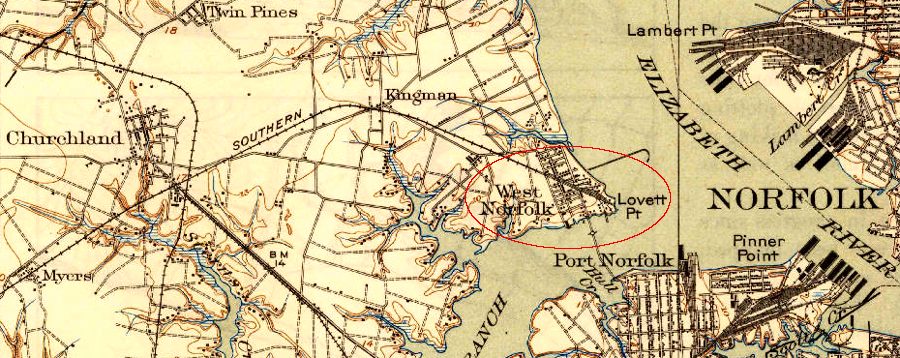
the Atlantic and Danville Railroad built its primary terminal on the Elizabeth River at West Norfolk before the Southern Railway leased it in 1899
Source: US Geological Survey (USGS), Newport News 1:62,500 topographic quadrangle (1941)
The Atlantic and Danville Railroad, as its name implied, intercepted the Roanoke River trade. It shipped manufactured processed tobacco and other products from Danville to the Elizabeth River. Unlike the Petersburg Railroad and the Seaboard and Roanoke Railroad, the trade was intercepted much further upstream from Weldon, North Carolina. Traffic which originated in the Roanoke River watershed as far west as Halifax County gained a direct rail outlet to an Elizabeth River port.
At Danville it interchanged with the Richmond and Danville Railroad, which brought agricultural products up from North Carolina to Richmond. The Atlantic and Danville Railroad also competed with the Atlantic Coast Line which went from Weldon to Petersburg via the former Petersburg Railroad, and the Seaboard Air Line which went to Portsmouth via the former Portsmouth and Roanoke (Seaboard and Roanoke) Railroad.
The Norfolk & Western Railroad was another competitor for traffic across the Piedmont from the Blue Ridge to the Chesapeake Bay. The Norfolk & Western (including what was formerly the Atlantic Mississippi & Ohio) carried freight from Bristol to Norfolk. Its wharves weree located on the east side of the Elizabeth River, opposite the Atlantic and Danville Railroad wharves at West Norfolk.
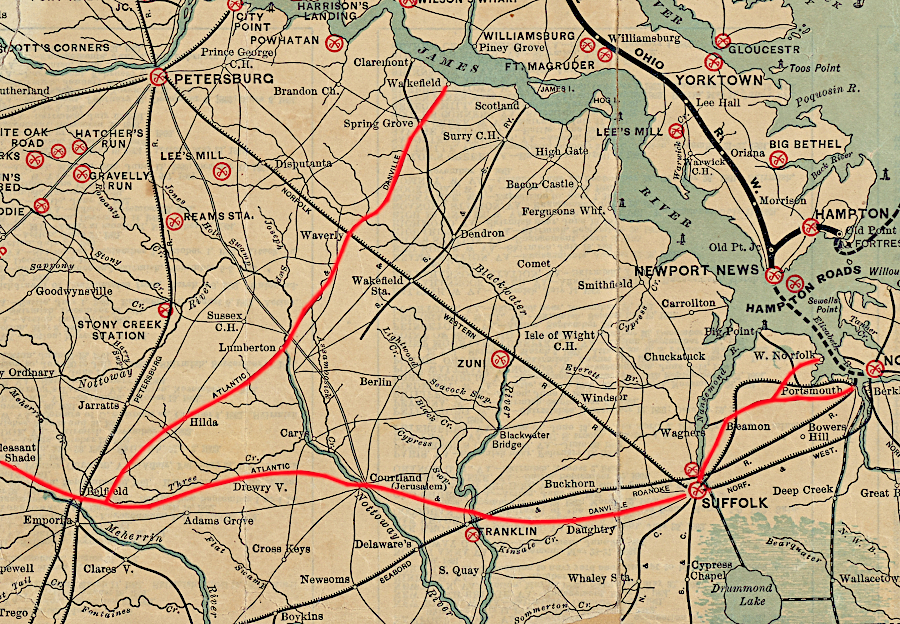
the Atlantic and Danville Railway includes lines to the James River and West Norfolk in 1891
Source: New York Public Library, Map showing the location of battle fields of Virginia (1891)
To finance the standard gauge line between the Elizabeth River and Danville, the Atlantic & Danville Railroad sold bonds. Benjamin Newgass and other English investors bought them, in hopes of profits generated by shipping Southern cotton to England via the Chesapeake Bay. In 1892, after the railroad had spent a year in receivership (bankruptcy), Newgass took control. He consolidated his authority in 1894.
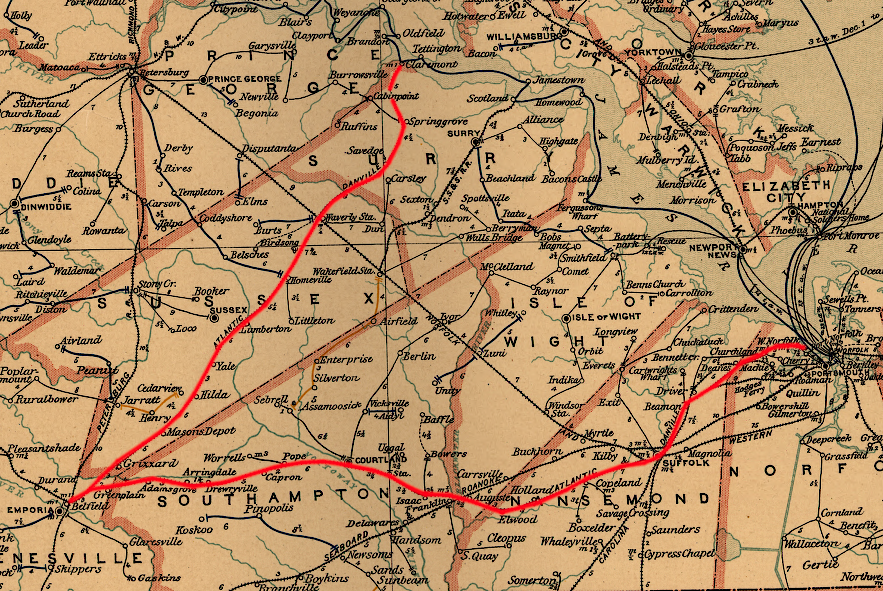
Atlantic & Danville Railroad in 1896
Source: Library of Congress, Post route map of the state of Virginia and West Virginia (1896)
Under his leadership, the railroad reduced mileage by abandoning its line from Shoulder Hill to Portsmouth and its facilities within the city limits. It also built a branch from Virgilina to the Holloway copper mine in North Carolina, but did not have the resources required to build west of Danville to create a major trunk line into the coal fields.4
William E. Griffin Jr., The Atlantic and Danville Railway Company, TLC Publishing, 2006, pp.2-7
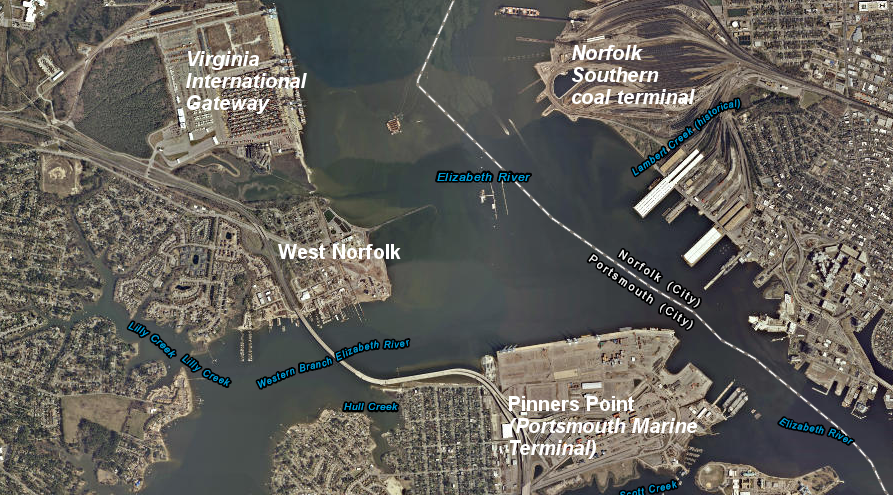
the Atlantic and Danville Railroad built terminals on both sides of the Western Branch of the Elizabeth River, first at West Norfolk and then at Pinners Point
Source: ESRI, ArcGIS Online
The Southern Railway arranged a 50-year lease of the Atlantic & Danville Railroad in 1899, as part of the consolidation of railroads following the Panic of 1893. The failure of the Richmond and Danville Railroad and the Richmond and West Point Terminal Railway and Warehouse Company ("the Terminal") helped bring an end to the excessive speculative expansion of the railroad network in Virginia after the Civil War.

between 1899-1949, the Southern Railway leased the Atlantic & Danville Railroad
Source: Virginia State Corporation Commission, Annual Report of the State Corporation Commission of Virginia - 1917 (p.66)
Acquiring control over the Atlantic & Danville Railroad gave the Southern another option for transporting freight and passengers to Portsmouth. The Southern Railway had obtained rights from the Atlantic Coast Line to use the old Norfolk and Carolina Railroad tracks from Tarboro to Pinners Point, but those rights could be lost if the Atlantic Coast Line went into receivership. Leasing the Atlantic & Danville Railroad was an insurance policy.
The Southern had another terminal located at West Point on the York River, built originally by the Richmond and York River Railroad and acquired by Richmond and Danville Railroad. West Norfolk was a more attractive location for exports via the Chesapeake Bay, but an old business arrangement created a problem.
The Richmond and Danville Railroad had promised the Seaboard and Roanoke Railroad that it would not compete and build a line to the Elizabeth River. In exchange, in the days before the US Congress passed anti-trust laws, the Seaboard and Roanoke promised that it would not operate a steamship line to Richmond/West Point and compete with the Richmond and Danville Railroad's dominance there.
By leasing the Atlantic and Danville Railroad, the Southern Railway was able to bypass the Richmond and Danville's promise not to start new facilities on the Elizabeth River. It expanded the Pinners Point facilities, making the Southern Railway's primary terminal on the Chesapeake Bay a site on the Elizabeth River rather than West Point on the York River. The port facilities at West Norfolk, built by the Atlantic and Danville, were abandoned.5
William E. Griffin Jr., The Atlantic and Danville Railway Company, TLC Publishing, 2006, pp.9-10, p.13
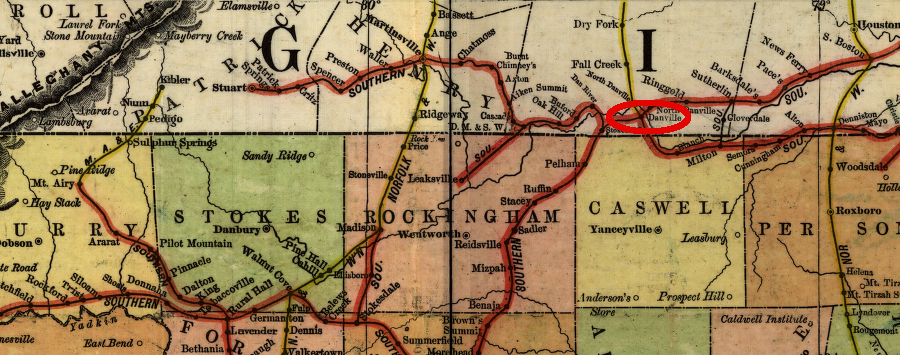
when the Southern leased the Atlantic & Danville Railroad in 1899, it included an extension west from Danville to Stuart
Source: Library of Congress, Railroad map of North Carolina, 1900 (H. C. Brown, 1900)
The rail network established by the Southern Railway implemented the vision of Benjamin Newgass and others to streamline the shipment of agricultural products and manufactured goods from the Piedmont to Atlantic Coast port cities. A narrower version of that vision was implemented by the Chesapeake and Ohio, Norfolk and Western, and Virginian railroads, which relied heavily upon the shipment of just one product - coal - to their Chesapeake Bay port destinations.
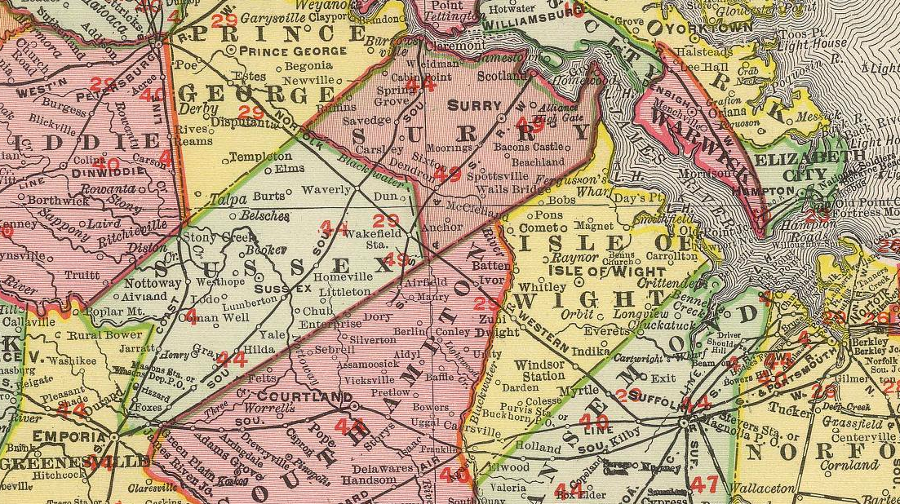
the Southern Railway leased the Atlantic and Danville Railroad for 50 years, between 1899-1949
Source: David Rumsey Historical Map Collection, Virginia (1903)
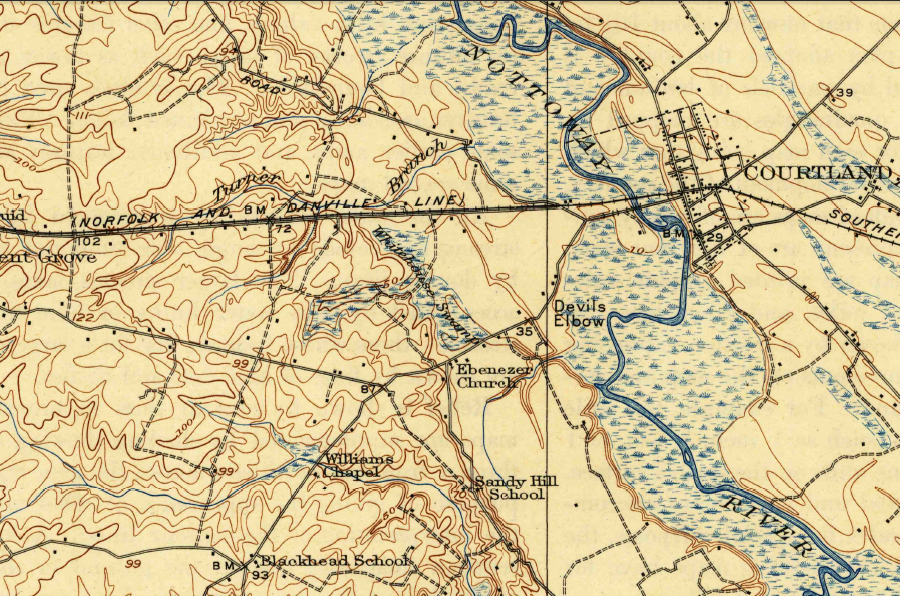
the Southern Railway leased the Atlantic and Danville between 1899-1949
Source: US Geological Survey (USGS), Boykins 1:62,500 scale topographic quadrangle (1920)
During the Great Depression, traffic dropped on the narrow gauge Claremont branch of the Atlantic and Danville Railroad. Since financing for new building construction was harder to obtain, demand for lumber declined precipitously.
The supply of timber in southeastern Virginia area crossed by the Atlantic and Danville Railroad was also declining. Landowners had not implemented sustainable forestry practices and were not replanting as fast as they harvested. The forests were "mined" rather than "farmed." The Gray Lumber Company at Waverly shipped its products on the Norfolk and Western Railway, chosing the standard gauge line over the narrow gauge Claremont Branch.
Once boats quit scheduling regular stops at Claremont Wharf in the late 1920's, all cars loaded with timber moved down the Claremont Branch to Emporia. Cargo from cars on the narrow gauge track was transferred to standard gauge cars at Emporia, then hauled to the Southern Railway's terminal at Pinners Point in Portsmouth on the Elizabeth River.
Traffic on the narrow gauge Claremont Branch declined significantly as lumbering operations ended. The Surry Lumber Company mill in Dendron closed in 1927. The nearby Surry, Sussex and Southampton Railway, another narrow-gauge line carrying timber products to Scotland Wharf on the James River downstream from Claremont, closed in 1930.
The Southern Railway finally abandoned the narrow-gauge Claremont Branch in 1932. The Gray Lumber Company arranged to maintain the track in order to operate its own trains, which carried timber to that company's mill at Waverly. The stretch north of Waverly was used until 1933, and the track south of Waverly was kept operational until 1938.6
William E. Griffin Jr., The Atlantic and Danville Railway Company, TLC Publishing, 2006, pp.9-10, p.15, pp.55-56; Jack Huber, "The Surry Lumber Company - Logs, Locomotives and Lumber," Virginia Forests, Winter, 2000, http://www.rootsweb.ancestry.com/~vaschs/SLCfinal.htm (last checked May 18, 2020)
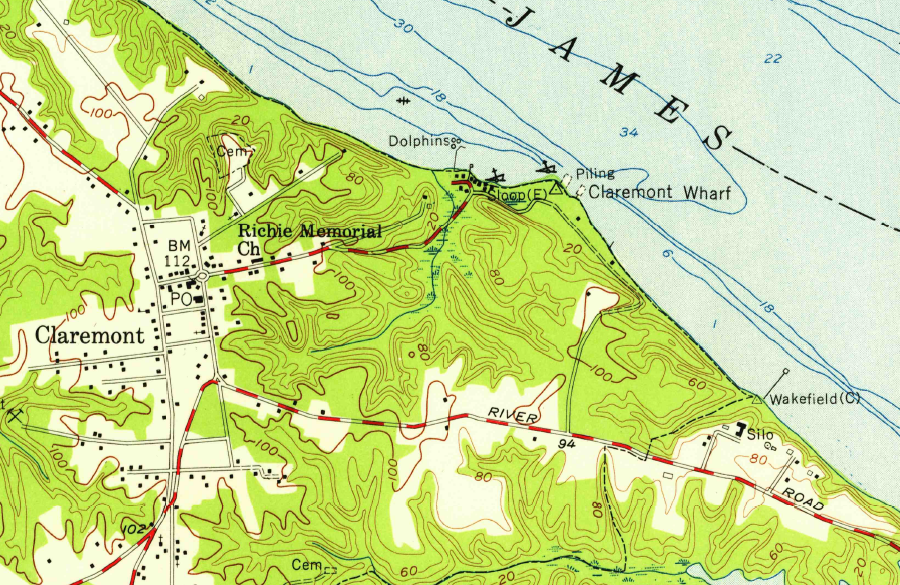
Claremont Wharf lost its railroad connection during the Great Depression
Source: US Geological Survey (USGS), Claremont 1:24,000 scale topographic quadrangle (1954)
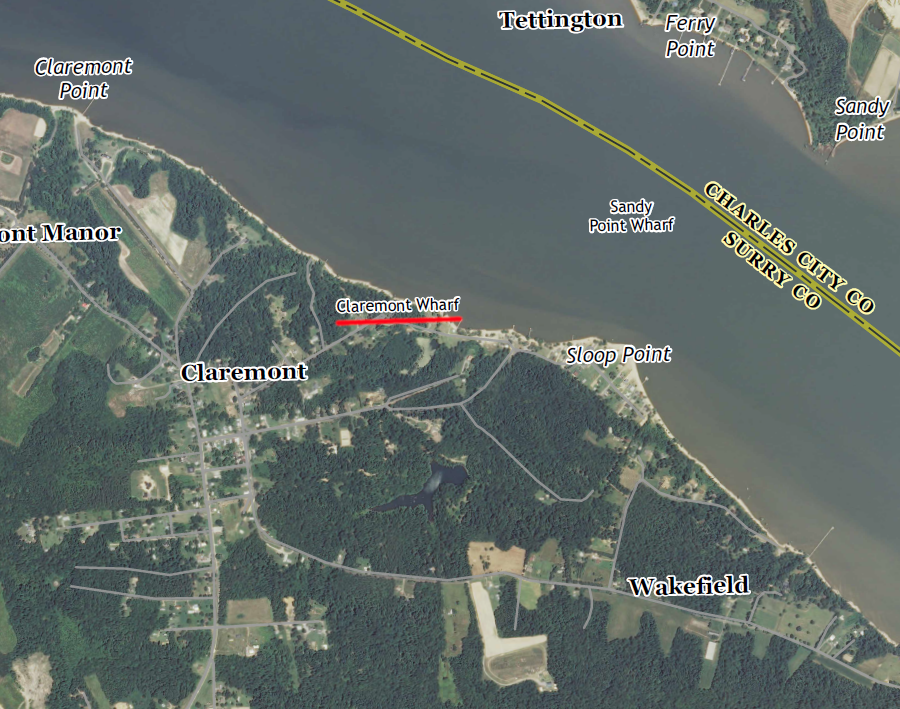
Claremont Wharf was still identified on US Geological Survey (USGS) maps in 2013
Source: US Geological Survey (USGS), Claremont 1:24,000 scale topographic quadrangle (2013)
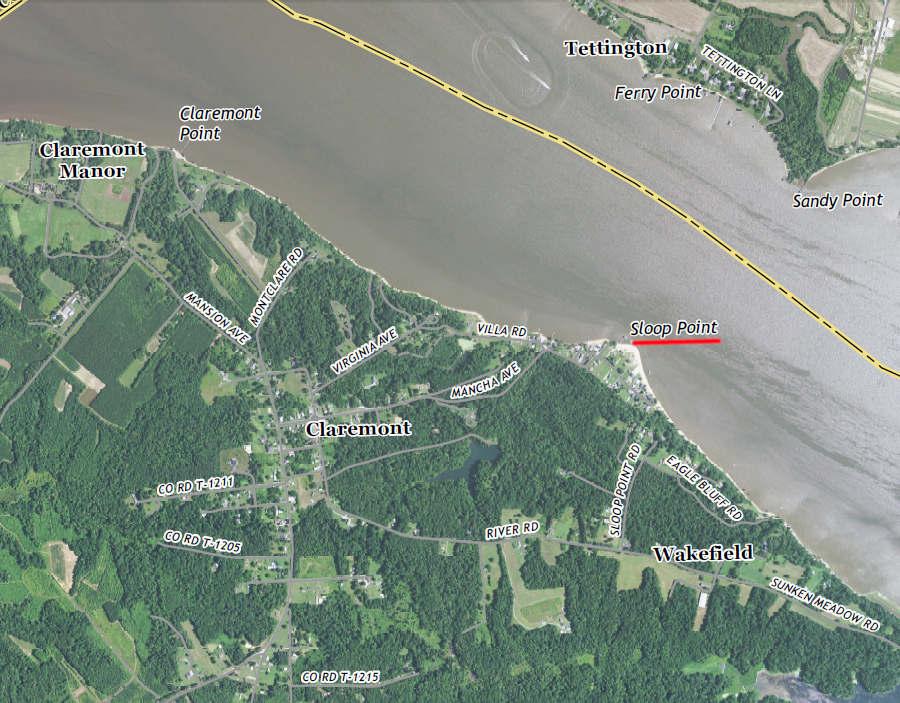
by 2019, Claremont Wharf was omitted from the US Geological Survey (USGS) maps
Source: US Geological Survey (USGS), Surry 1:62,500 scale topographic quadrangle (2019)
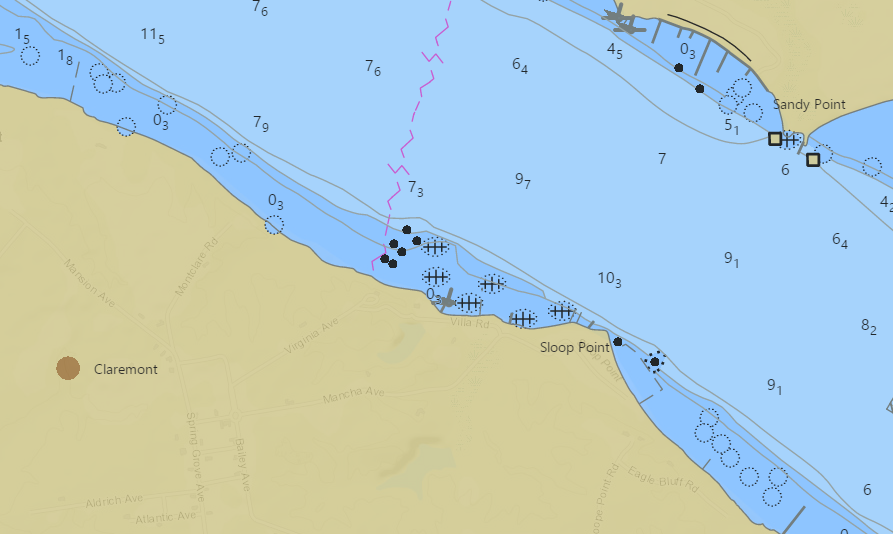
modern navigation charts mark pilings and wrecks, evidence of Claremont Wharf's past existence
Source: National Oceanic and Atmospheric Administration (NOAA), Electronic Navigational Charts
After the boom years of World War II, traffic on the Atlantic and Danville Railroad track between Danville and Pinners Point declined again. Trucks competed successfully for much of the freight-hauling business of the railroads.
The Southern Railway had signed a 50-year lease of the the Atlantic and Danville Railroad in 1899. Even during the increased business to and from Portsmouth stimulated by World War II, it was clear that continued operations would be very profitable. Rather than renew the 50-year lease when it expired in 1949, the Southern Railway chose to relinquish control. It gave notice in 1944, five years before the lease expired.
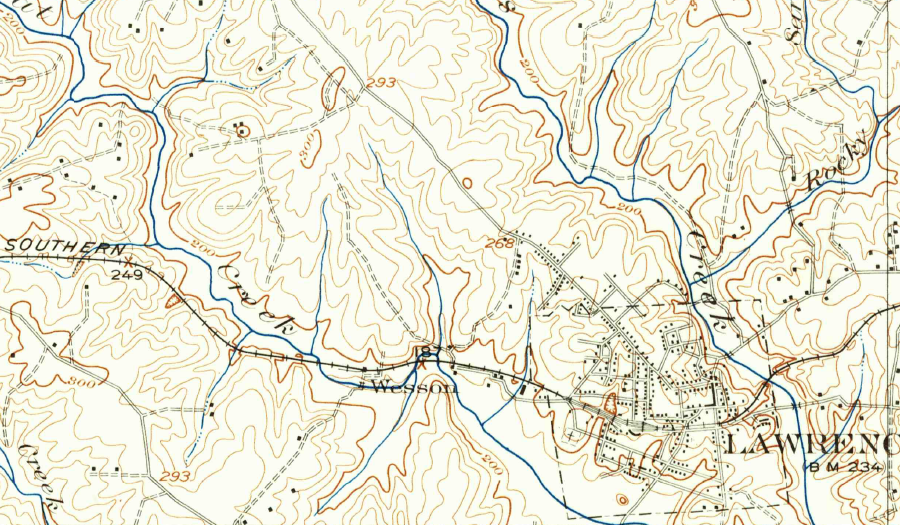
in 1918, the Southern Railway operated though Lawrenceville on the leased tracks of the Atlantic & Danville Railroad
Source: US Geological Survey (USGS), Lawrenceville VA 1:62,500 topographic quadrangle (1918)
The Atlantic & Danville Railroad had stayed alive as a paper corporation for the 50 years that the Southern Railway had leased it. The Claremont Branch and the port facilities at West Norfolk had been abandoned, and the track was not upgraded to serve as the Southern's mainline, but the railroad was still a viable business in 1949. The Southern Railway was obligated to leave the Atlantic & Danville with enough equipment to allow operations comparable to the railroad's capacity in 1899, so those holding stock in the Atlantic & Danville Railroad chose to restart the railroad.
After the Southern Railway's 50-year lease expired in 1949, the Atlantic & Danville Railroad operated again as an independent line for another 13 years. As part of the "divorce" from the Southern Railway, the Atlantic & Danville Railroad kept the right to use the 2-mile stretch of Southern Railway track crossing the Roanoke River, built originally by the Richmond and Mecklenburg Railroad.
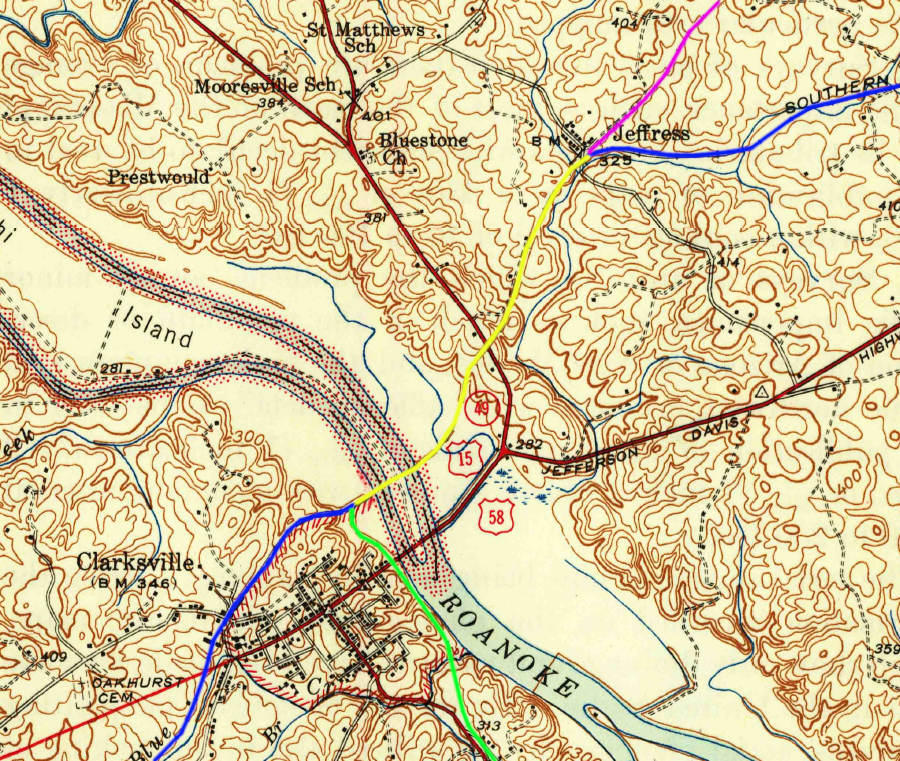
the Atlantic and Danville Railway (blue line) leased track (yellow) built originally by the Richmond and Mecklenburg Railroad (purple) connecting to the Oxford and Clarksville Railroad (green)
Source: US Geological Survey, Clarksville VA 1:62,500 topographic quadrangle (1943)
On the eastern end, the Atlantic & Danville Railroad obtained trackage rights to the Southern Railway's shipping terminal at Pinners Point. Use of the Pinners Point terminal was essential, because the wharves on the Elizabeth River at West Norfolk had been removed after the Southern Railway lease was executed in 1899.
The Korean War created profitable traffic to Fort Pickett and other military facilities on the Atlantic & Danville Railroad. Construction of Kerr Dam, creating what the Virginia General Assembly named Buggs Island Lake but known to others as Kerr Reservoir, also increased business. However, maintenance and operating costs exceeded revenues in most years.7
William E. Griffin Jr., The Atlantic and Danville Railway Company, TLC Publishing, 2006, pp.15-17. p.30
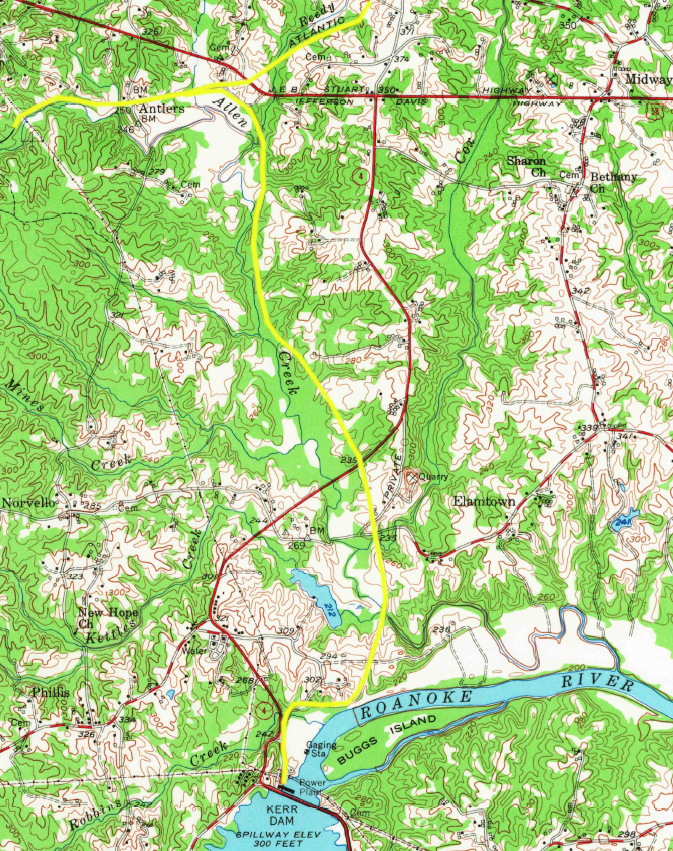
the Atlantic and Danville Railway (yellow line) build a branch line in Mecklenburg County to haul construction material to the Kerr Dam
Source: US Geological Survey, Boydton VA 1:62,500 topographic quadrangle (1955)
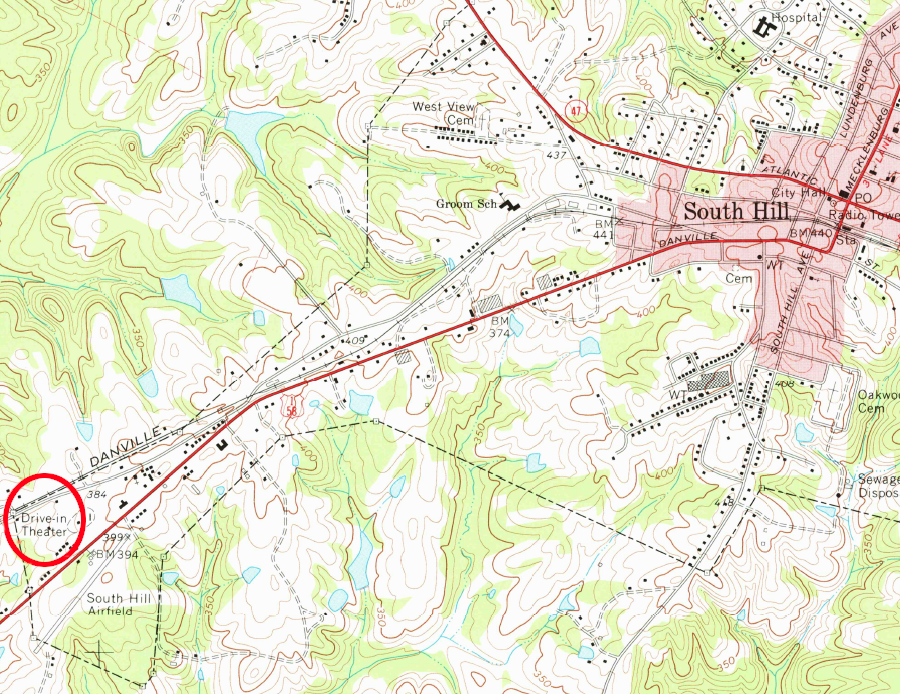
the Norfolk, Franklin & Danville Railway passed by the drive-in theater near South Hill (Mecklenburg County)
Source: US Geological Survey (USGS), South Hill 1:24,000 scale opographic quadrangle (1968)
The Atlantic & Danville Railroad went into receivership in 1960 and was acquired by the Norfolk and Western Railway in 1962. The Norfolk and Western Railway renamed the line as the Norfolk, Franklin & Danville Railway.8
"ICC Approves N&W's Acquisition of Bankrupt Atlantic-Danville Road," Wall Street Journal, October 30, 1962, p.4
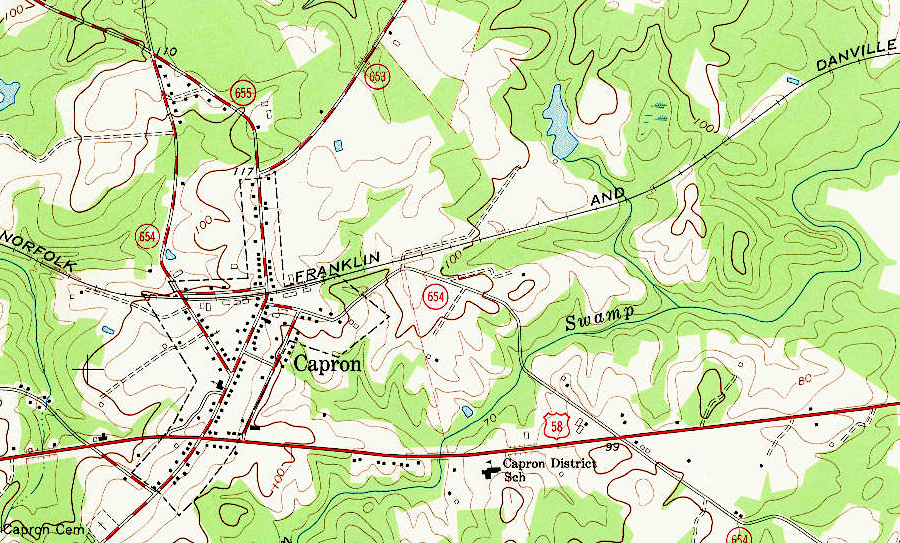
the route of the Norfolk, Franklin & Danville Railway is now Railroad Avenue in Capron (Southampton County)
Source: US Geological Survey (USGS), Capron VA 1:24,000 scale opographic quadrangle (1966)
The Norfolk, Franklin & Danville Railway's distinctive identity disappeared a year after the Norfolk and Western Railway had merged in 1982 with the Southern Railway to form the Norfolk Southern Railroad. The route of the Atlantic and Danville Railroad was folded into the Norfolk Southern Railroad in 1983.
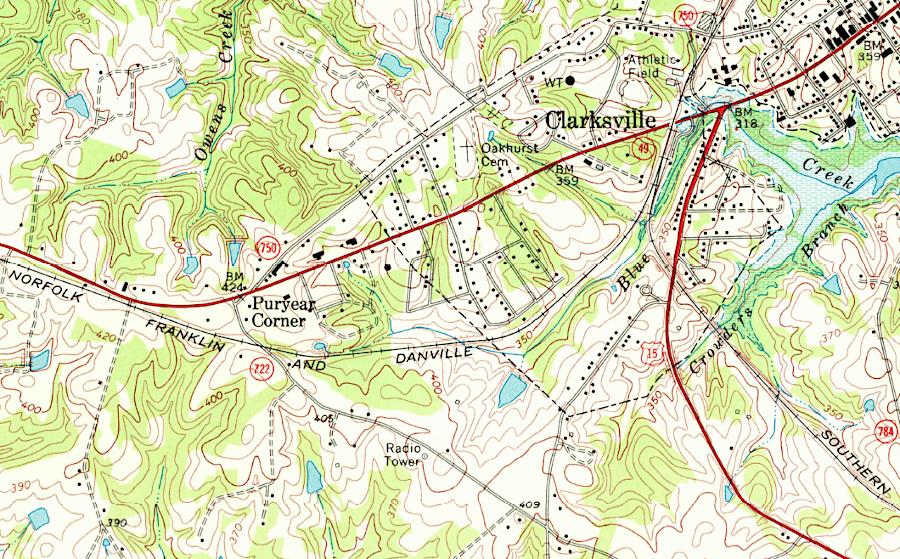
the Norfolk, Franklin & Danville Railway connection with the Southern Railway in Clarksville in 1968
Source: US Geological Survey (USGS), Clarksville South, VA 1:24,000 topographic quadrangle (1968)
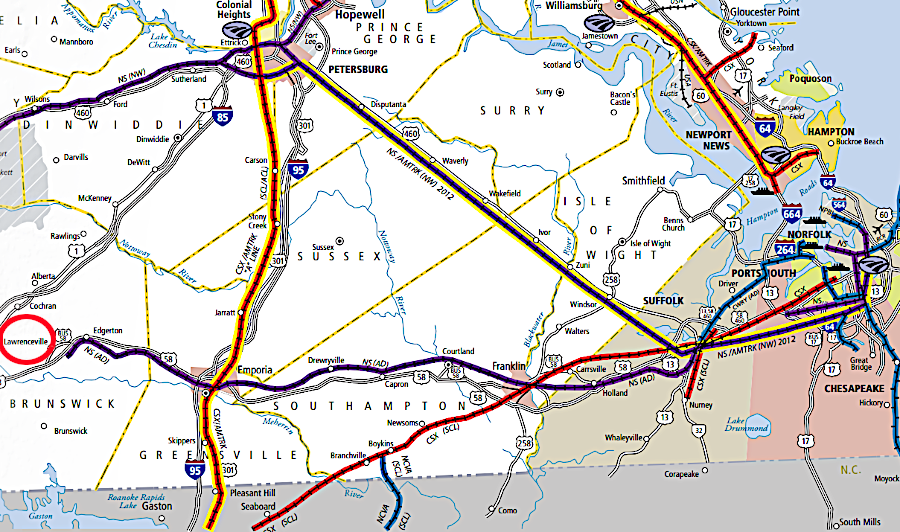
the western end of the Norfolk, Franklin & Danville Railway was at Lawrenceville until 2014
Source: Virginia Department of Rail and Public Transportation (DRPT), State Rail Map (2012)
It became unprofitable for the Norfolk Southern to maintain track that was duplicated in the consolidated system. Track from Blanche, North Carolina, to Lawrenceville was abandoned between 1982-89. From Lawrenceville to La Crosse, the roadbed was used for the Tobacco Heritage Trail, which also utilizes abandoned right-of-way of the Virginian Railway and the original route of the Richmond and Danville Railroad. A portion of that route near Boydton is also open now as a rail-to-trail conversion.8
"Tobacco Heritage Trail History," TrailLink, https://www.traillink.com/trail-history/tobacco-heritage-trail/ (last checked July 8, 2020)
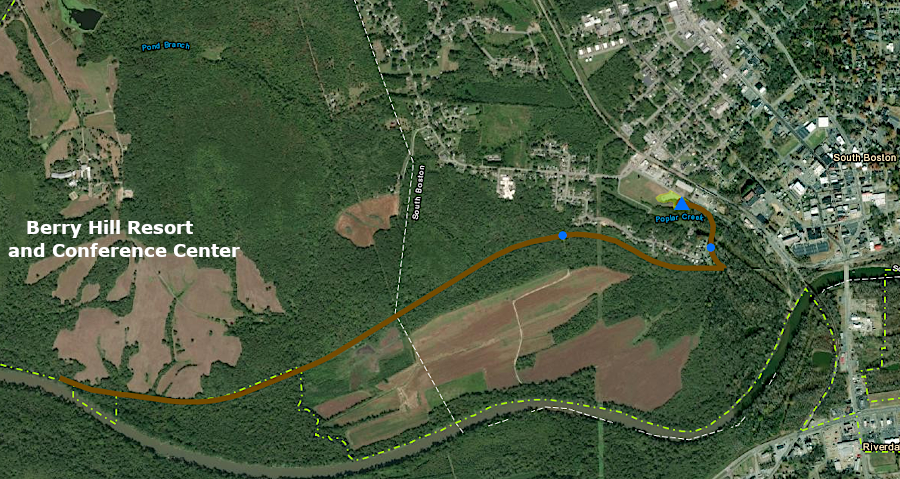
the Atlantic & Danville Railroad route west from South Boston to Berry Hill is now part of the Tobacco Heritage Trail
Source: Tobacco Heritage Trail
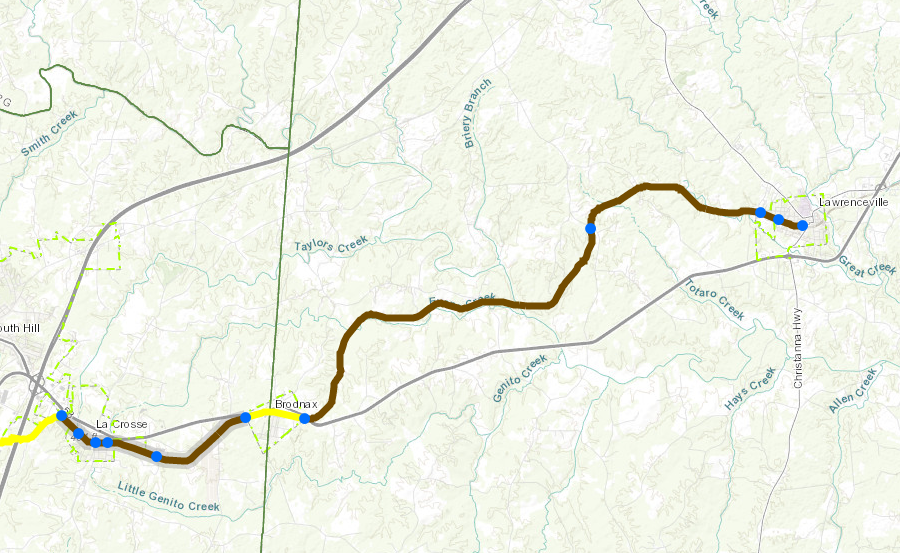
the Tobacco Heritage Trail uses the Atlantic & Danville Railroad route from Lawrenceville-La Crosse
Source: Tobacco Heritage Trail
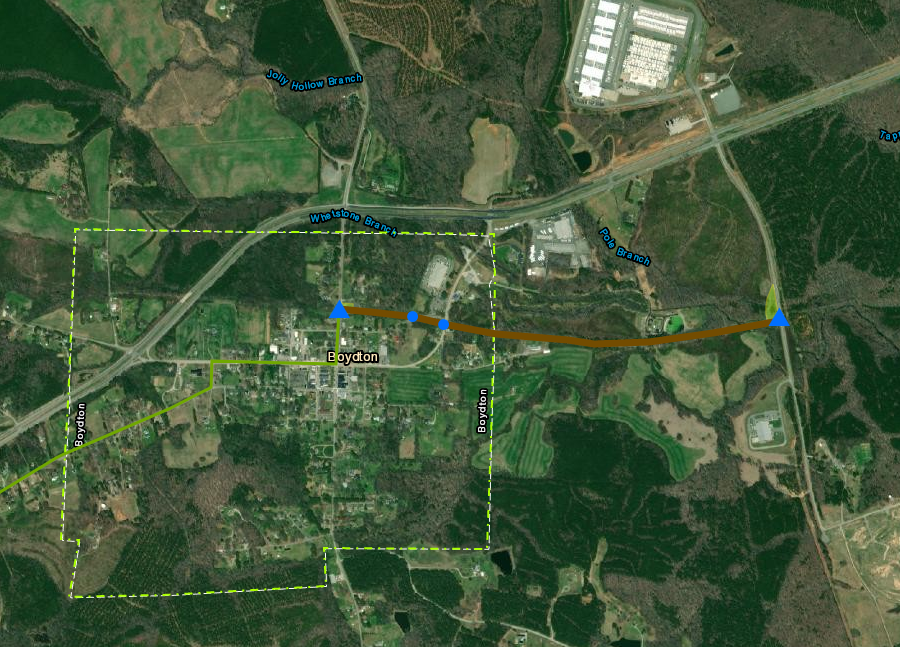
a segment of the Atlantic & Danville Railroad is now a gravel/rock dust trail near Boydton
Source: Tobacco Heritage Trail
After 1989, the remainding track east of Lawrenceville became a branch line providing service to a few remaining customers. In 2013, the track and trestles were no longer adequate to allow continued operations and traffic was embargoed.
In 2014, the Norfolk Southern gained permission from the Surface Transportation Board to end service on 53 miles of the old Atlantic and Danville Railroad route, from Lawrenceville east to Franklin. A primary customer, the Vulcan Construction Materials quarry at Edgerton, had shifted its production to facilities away from the railroad track. One of the remaining five customers went bankrupt.
The two customers who generated most of the remaining traffic were in Emporia, next to I-95. Norfolk Southern considered creating an "island" operation there to provide continued rail service, but it would have required building an expensive connection to the CSX operating on the route originally established by the Petersburg Railroad.
Though the Norfolk Southern received Federal approval to discontinue service, the track was not abandoned. A rail-to-trail conversion of the 53 miles of track would be a possibility only if the stretch was abandoned, with no potential for restoration of rail service.8
"Norfolk Southern discontinues local line," Tidewater Review, April 4, 2014, https://trn.trains.com/news/news-wire/2013/12/ns-to-discontinue-service-over-former-norfolk-franklin--danville; "Norfolk Southern Railway Company Discontinuance of Service Exemption In Isle of Wight, Southampton, Greensville, and Brunswick Counties, Virginia," Surface Transportation Board (STB) Docket No. AB-290 (Sub-No. 359X), November 26, 2013, p.15, p.25, p.33, https://www.stb.gov/filings/all.nsf/ba7f93537688b8e5852573210004b318/716d46c6b55c085485257c2f0079961b/$FILE/235127.pdf (last checked July 8, 2020)
Service was dropped between Franklin-Suffolk in 2013. That track was also so unsafe that it had to be embargoed; an upgrade with continued maintenance would not have been cost-effective after International Paper closed down its mills in Franklin. The entire Franklin-Lawrenceville stretched lacked the freight traffic to justify continued operations.8
"NS to discontinue service over former Norfolk, Franklin & Danville," Tidewater Review, December 26, 2013, https://trn.trains.com/news/news-wire/2013/12/ns-to-discontinue-service-over-former-norfolk-franklin--danville (last checked July 8, 2020)
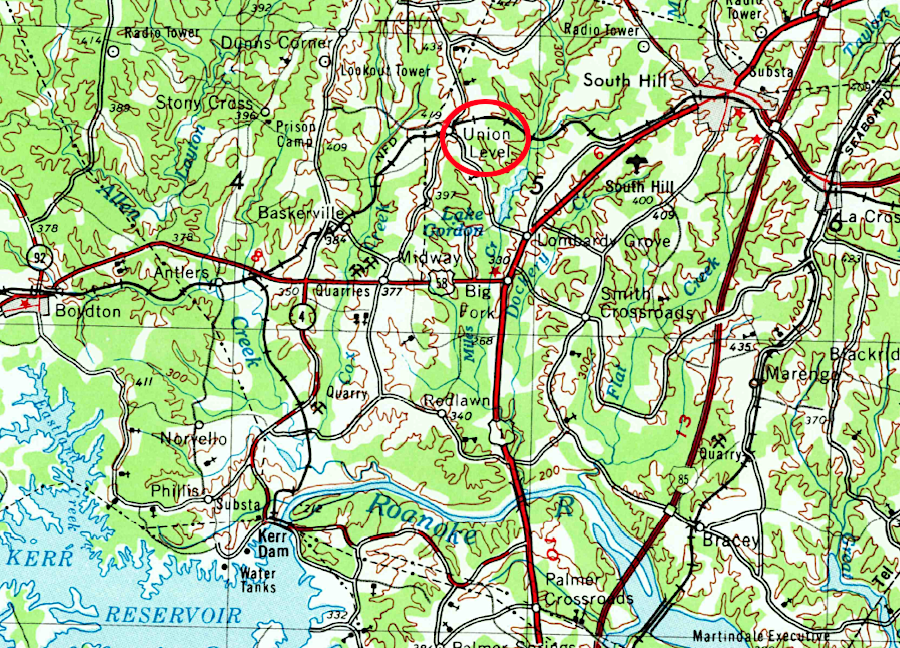
Union Level in Mecklenburg County became a ghost town after the railroad was abandoned
Source: US Geological Survey (USGS), Greensboro NC 1:250,000 scale opographic quadrangle (1953)
The only portion of the old Atlantic and Danville Railroad still in use by trains is the branch from Suffolk to the West Norfolk site on the Elizabeth River Norfolk Southern recognized that chemical plants there generated enough business to create a shortline railroad and lease that 17-mile stretch as part of the Thoroughbred Short Lines program. The Commonwealth Railway now handles the container traffic generated at West Norfolk, and especially from the Virginia International Gateway terminal north of it.8
"The Norfolk, Franklin & Danville Railway," American-Rails.com, http://www.american-rails.com/norfolk-franklin-and-danville-railway.html (last checked July 8, 2020)
Repurposing abandoned portions of the Atlantic & Danville Railroad is underway. The Tobacco Heritage Trail, spurred by the Roanoke River-Rails-to-Trails effort and local governments, will follow routes of the Atlantic and Danville, Richmond and Danville, and Virginian railroads. Economic development leaders anticipate that tourism will help to offset the decline of manufacturing jobs in Southside Virginia.9 "The Tobacco Heritage Trail expands," WashCycle, March 27, 2014, https://www.thewashcycle.com/2014/03/the-tobacco-heritage-trail-expands.html; "County kick starts next phase of Tobacco Heritage Trail," The Gazette-Virginian, March 30, 2016, http://www.yourgv.com/lifestyles/county_life/county-kick-starts-next-phase-of-tobacco-heritage-trail/article_214ab1da-f675-11e5-951c-b712e8a4acd6.html; "Tag: Tobacco Heritage Trail," Mecklenburg County, http://visitmeckva.com/tag/tobacco-heritage-trail/ (last checked December 18, 2018)
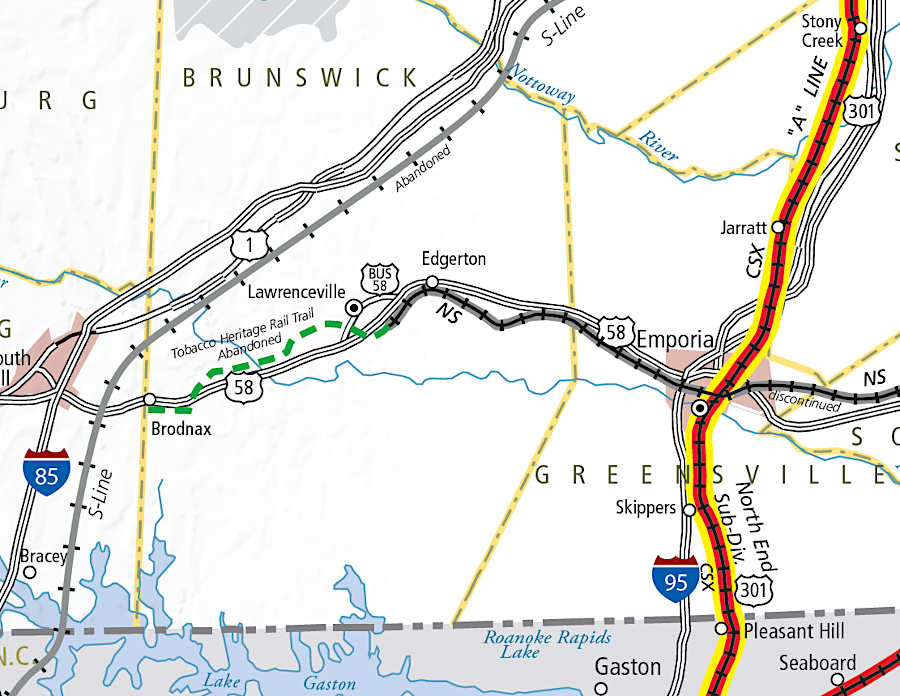
the Norfolk, Franklin & Danville Railway west of Lawrenceville is now being developed as the Tobacco Heritage Trail
Source: Virginia Department of Rail and Public Transportation (DRPT), Virginia Rail Map (2019)
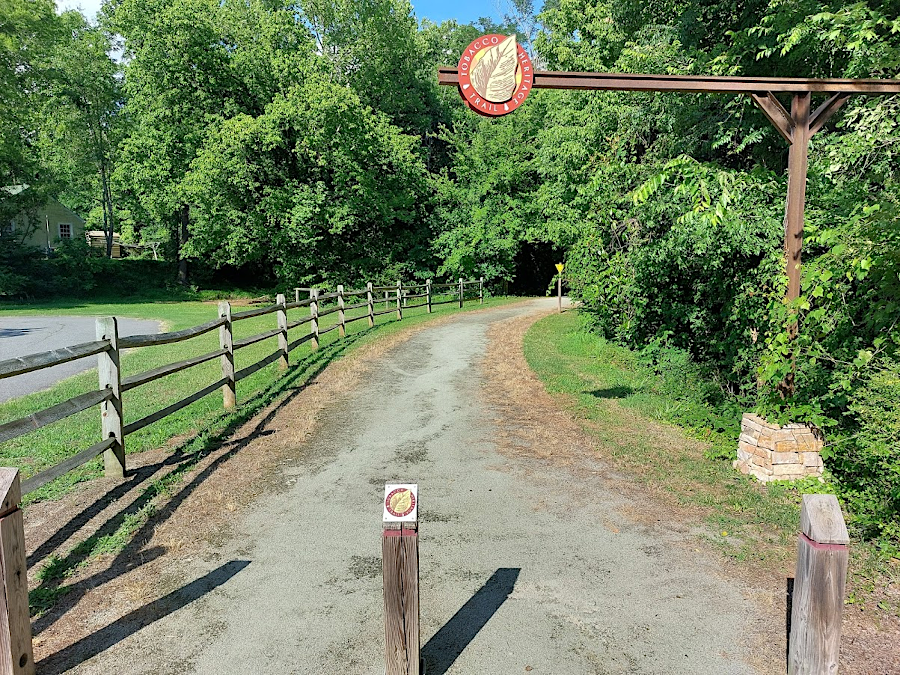
the old Norfolk, Franklin & Danville Railway at High Street in La Crosse is now part of the Tobacco Heritage Trail
Between Suffolk and Emporia, the Beaches to Bluegrass Trail will use the Atlantic & Danville Railroad right-of-way.
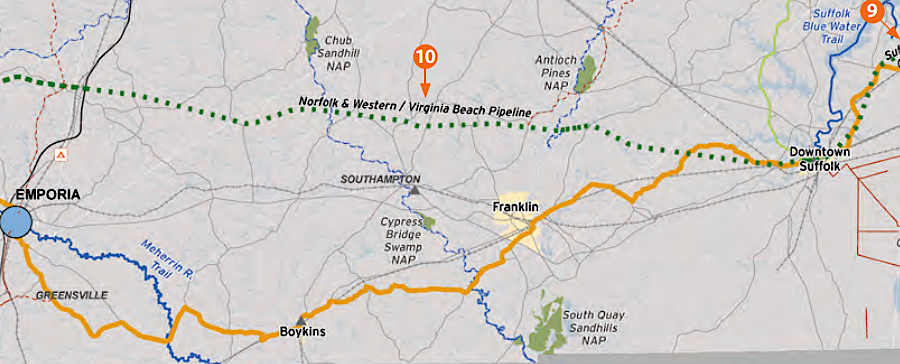
the original Atlantic & Danville Railroad right-of-way beween Suffolk-Emporia is intended to become the Beaches to Bluegrass Trail
Source: Virginia Department of Conservation and Recreation, Beaches to Bluegrass Trail Master Plan
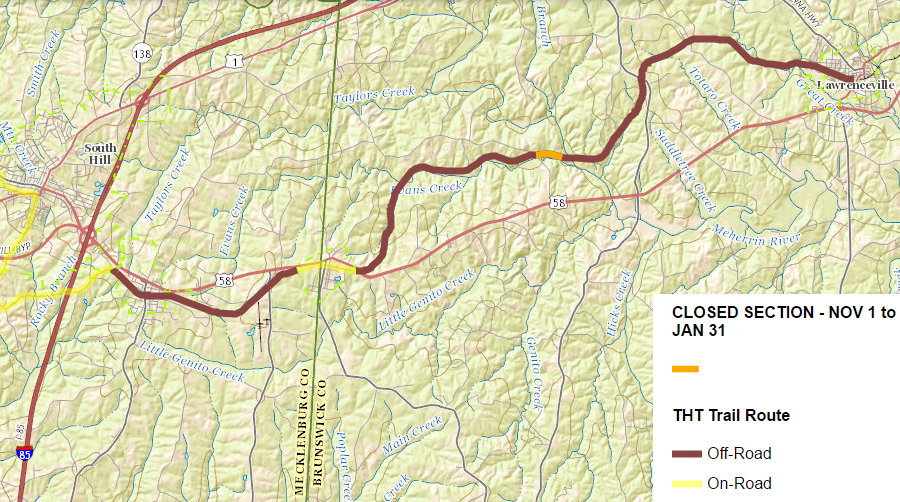
the Tobacco Heritage Trail between Lawrenceville and South Hill follows the old route of the Atlantic and Danville Railroad
Source: Tobacco Heritage Trail, Tobacco Heritage Trail Webmap
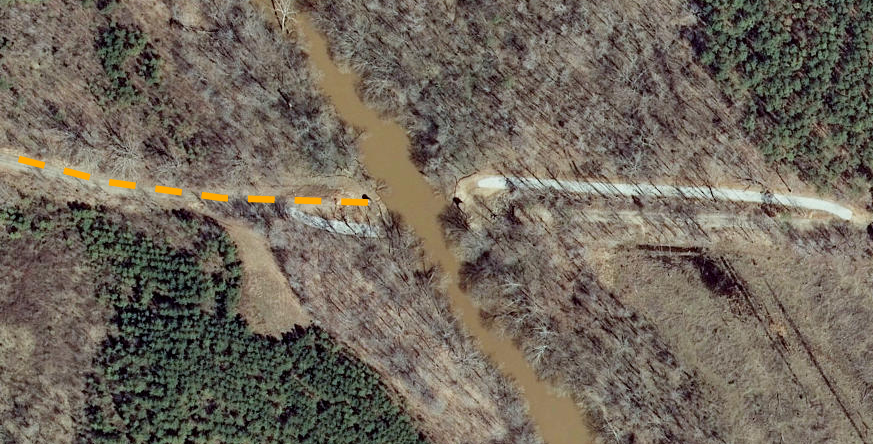
the Tobacco Heritage Trail needs a replacement of the old Atlantic and Danville Railroad bridge over the Meherrin River
Source: Tobacco Heritage Trail, Tobacco Heritage Trail Webmap

the Atlantic and Danville Railroad reached Damville as its western end; the Danville and New River Railroad connected furher west to Stuart
Source: New York Public Library, Mineral territory tributary to Norfolk and Western Railroad (1890)
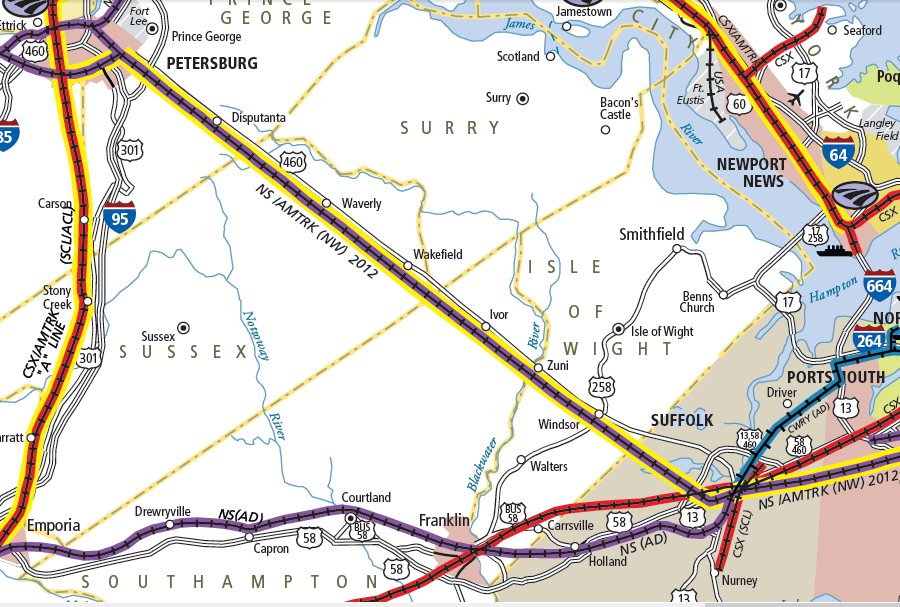
no railroad tracks go northeast through Sussex and Surry counties to the James River - and the Norfolk, Franklin & Danville Railway shut down as well in 2014
Source: Virginia Department of Rail and Public Transportation (DRPT), State Rail Map (2018)